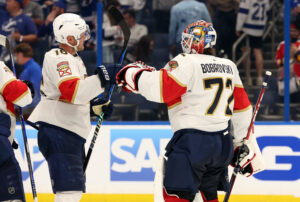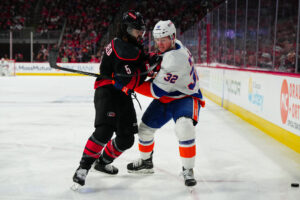Since the St. Louis Blues won the Stanley Cup back in June, all the talk has been about what a feel-good moment in sports this was. Recently, at the ESPY awards, the Blues were given the award for Comeback Team of the Year. While this is a phenomenal story, there is another side of the story you won’t read. In a two-part series, we take a look at how the NHL has created a false sense of parity through the current point system and a hard salary cap.
NHL False Sense Of Parity: Where It All Began
Coming out of the 2004-05 lockout, the NHL introduced new rules to make the game on the ice better for the fans.
One of the new concepts the NHL came up with was the elimination of ties. The league introduced the shootout to make sure that all regular-season games had a winner. The league had to create the current point system where a win is worth two points and teams earn a point for an overtime or shootout loss. Regulation wins are used in the tie-breaking formula to determine playoff berths.
However, there is terrible inconsistency with this theory as the team on the losing end received a point no matter if they lost in overtime or in the shootout. What other professional sports league besides the NHL rewards losing with a point?
Ties were always a part of hockey and were an honourable result. However, the NHL wanting to increase parity thought it best to eliminate ties from the game. So what did the NHL decide to do reward losing?
The league created three-point games that maintain the illusion of increased competition. If a team piles up enough single points in defeat a coach or general manager can keep saying that “Hey we’re okay. We’re only four points out of the playoffs.”
That is exactly what happened this year with the St. Louis Blues. There was talk about how the Blues were going to trade some pieces off, but all of sudden the Blues were able to stick around by putting some wins together and picking up the third point in their losses. Nobody else in the Western Conference seemed to grab the bull by the horns. Instead, the teams in front of the Blues let them stick around in the standings. This ultimately ended in the Blues winning the Stanley Cup.
The bonus point is being used for the wrong reasons and not for what it was originally intended. One night during the 2018-19 regular season, the NHL had a record EIGHT games go to overtime or a shootout. What is wrong with this picture?
Mediocrity or Parity?
With the bonus point being handed out each and every time a game goes to extra time, the NHL is able to claim they are the sports league with the most parity. However, that is not the case. Instead, it is really false parity. Just take a look at the standings as evidence. Before the third point was introduced, everyone knew around Game 36 who the best teams were. Since the third point has been introduced it takes around Game 72 to figure that out.
There is something wrong with this picture, that it should take until the end of the season to figure out who the best teams are. Finding out who the best team should happen midway through the season, never at the very end. For the NHL, they look it as parity, but what it is just a mirage.
The simple fact is that once a team gets on the wrong side of this equation, three-point games make the hole tougher to climb out of. When contenders play close tough games, they are dividing the three points on many nights.
Another problem with the third point is that one team will make the playoffs because they have accumulated more OT/SO loss points than another team, which is insane. This should not be the case.
While there will always be elite teams and horrible teams in the NHL, the problem of the third point lies in the teams that are mediocre. Parity is good up to a point but like all sports we want the best teams playing for the championship. As far we love the upsets early on, but in the end, it needs to be the best teams.
Solution
Just fix the point system altogether and get rid of the bonus point. Why should a professional sports league reward losing?
It is time for a change in the point system, and it is simple as 3-2-1. While the playoffs can be exciting in the current point structure. The system exposes the fact that what the NHL calls parity is just mediocrity. Whenever there is a game involving two teams needing points, the third point always seems to be a factor.
The 3-2-1 point system is nothing new to hockey. International tournaments like the Olympics, the World Hockey Championships, and the World Junior Hockey Championships use this system.
The idea would be to reward teams who won in regulation with three points, two for an overtime or shootout win, and one point for an overtime or shootout loss. Except in this scenario, there would be no bonus point. The new system would also allow teams to be able to climb out of a deep hole more quickly.
Under the international system, teams are forced to play harder. Whether that be at the end of regulation and in overtime. The crucial extra point could mean the difference between first or second in the group.
Under the current format, too many teams play for the bonus point instead of going for the outright win. If the NHL were to adopt a system like this, teams would have to go for the win instead just sitting back. With no safety net of the bonus point games would be more entertaining.
Don’t mistake what the NHL calls parity as anything more than mediocrity.
Main Photo: TORONTO, ONTARIO – NOVEMBER 09: NHL Commissioner Gary Bettman is introduced to fans during a pregame ceremony for the Hockey Hall of Fame prior to the Toronto Maple Leafs taking on the New Jersey Devils at the Scotiabank Arena on November 09, 2018 in Toronto, Ontario, Canada. (Photo by Bruce Bennett/Getty Images)






